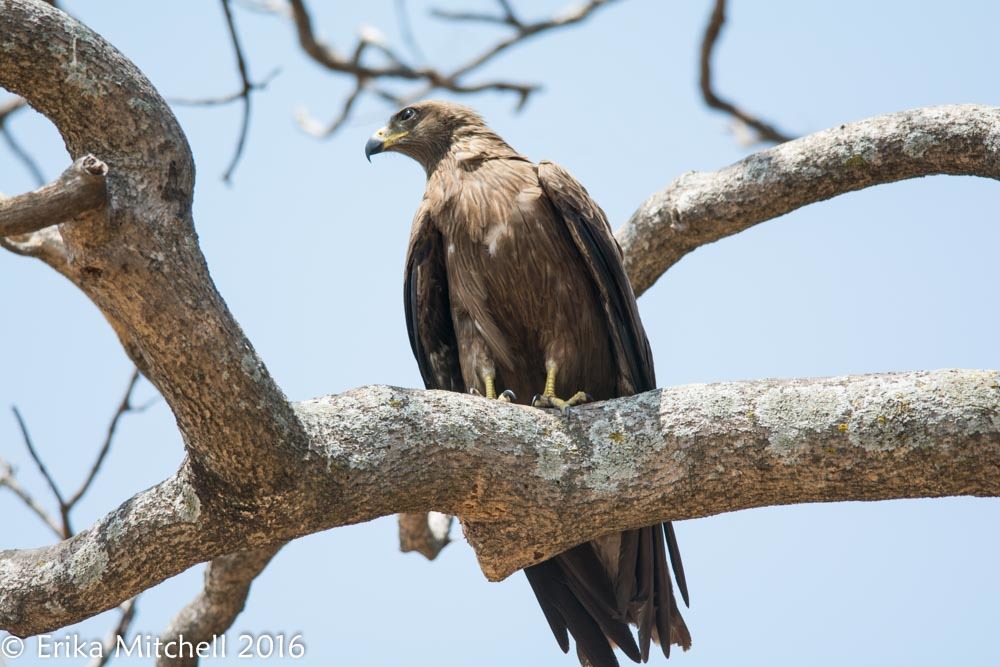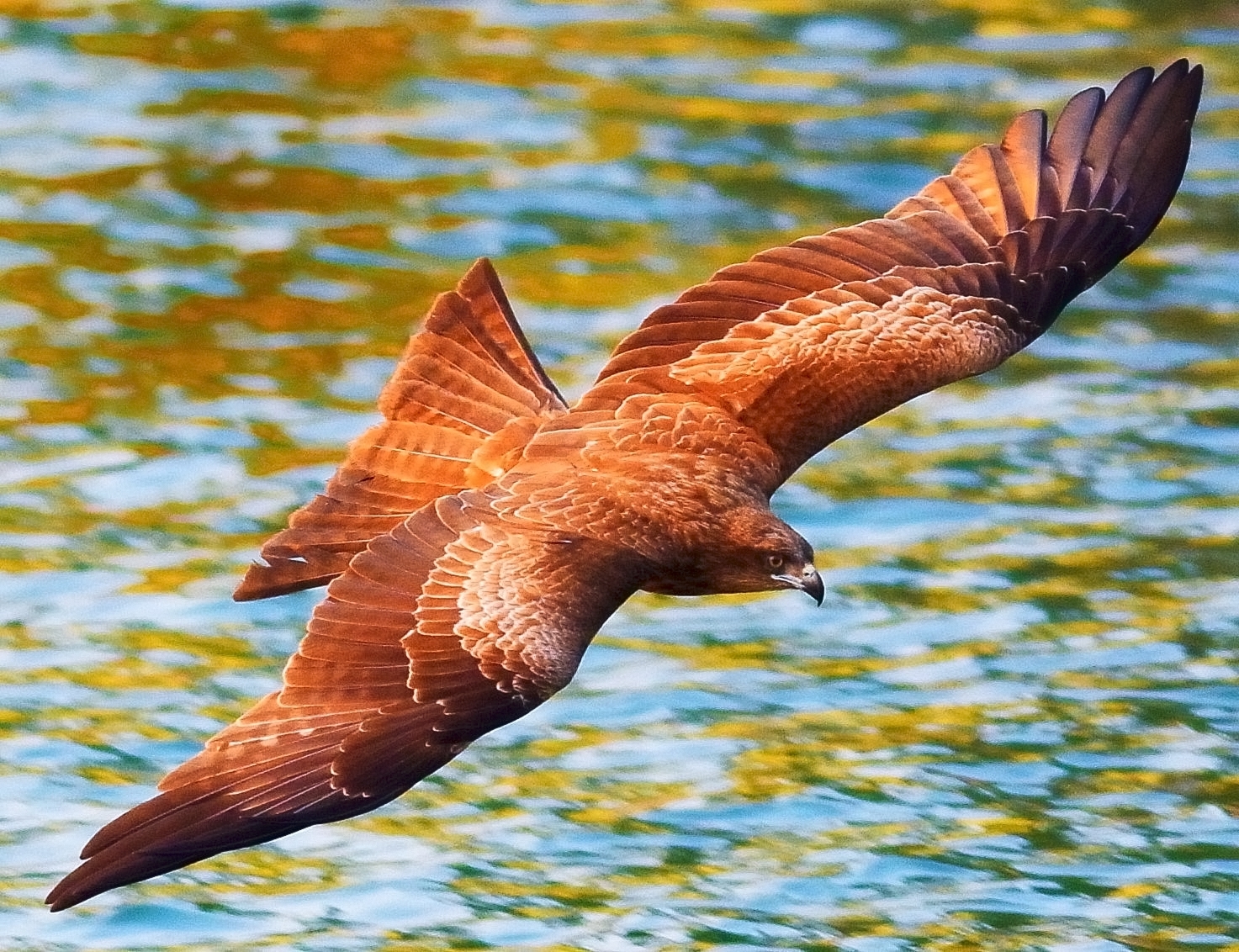- Home
- Conservancy
- Black Kite
Description
The black kite (Milvus migrans) is a medium-sized bird of prey in the family Accipitridae, which also includes many other diurnal raptors. It is thought to be the world's most abundant species of Accipitridae, although some populations have experienced dramatic declines or fluctuations. Current global population estimates run up to 6 million individuals. Unlike others of the group, black kites are opportunistic hunters and are more likely to scavenge. They spend a lot of time soaring and gliding in thermals in search of food. Their angled wing and distinctive forked tail make them easy to identify.
They are also vociferous with a shrill whinnying call. This kite is widely distributed through the temperate and tropical parts of Eurasia and parts of Australasia and Oceania, with the temperate region populations tending to be migratory. Several subspecies are recognized and formerly had their own English names. The European populations are small, but the South Asian population is very large.
Description
Black kites can be distinguished from red kites by the slightly smaller size, less forked tail (visible in flight), and generally dark plumage without any rufous. The sexes are alike. The upper plumage is brown but the head and neck tend to be paler. The patch behind the eye appears darker. The outer flight feathers are black and the feathers have dark cross bars and are mottled at the base. The lower parts of the body are pale brown, becoming lighter towards the chin. The body feathers have dark shafts giving it a streaked appearance. The cere and gape are yellow, but the bill is black (unlike in the yellow-billed kite). The legs are yellow and the claws are black. They have a distinctive shrill whistle followed by a rapid whinnying call. Males and females have the same plumage but females are longer than males. Their wingspan is around 150 cm
Fun Facts
Behaviour And Ecology
Food And Foraging
Black kites are most often seen gliding and soaring on thermals as they search for food. The flight is buoyant and the bird glides with ease, changing directions easily. They will swoop down with their legs lowered to snatch small live prey, fish, household refuse and carrion, for which behaviour they are known in British military slang as the shite-hawk. They are opportunist hunters and have been known to take birds, bats,and rodents. They are attracted to smoke and fires, where they seek escaping prey. This behaviour has led to Australian native beliefs that kites spread fires by picking up burning twigs and dropping them on dry grass.The Indian populations are well adapted to living in cities and are found in densely populated areas. Large numbers may be seen soaring in thermals over cities. In some places, they will readily swoop and snatch food held by humans.
Black kites in Spain prey on nestling waterfowl especially during summer to feed their young. Predation of nests of other pairs of black kites has also been noted. Kites have also been seen to tear and carry away the nests of baya weavers in an attempt to obtain eggs or chicks.
Flocking And Roosting
In winter, kites form large communal roosts. Flocks may fly about before settling at the roost.When migrating, the black kite has a greater propensity to form large flocks than other migratory raptors, particularly prior to making a crossing across water. In India, the subspecies govinda shows large seasonal fluctuations with the highest numbers seen from July to October, after the monsoons, and it has been suggested that they make local movements in response to high rainfall.
Breeding
The breeding season of black kites in India begins in winter (mainly January and February), the young birds fledging before the monsoons. The nest is a rough platform of twigs and rags placed in a tree. Nest sites may be reused in subsequent years. European birds breed in summer. Birds in the Italian Alps tended to build their nest close to water in steep cliffs or tall trees.Nest orientation may be related to wind and rainfall.The nests may sometimes be decorated with bright materials such as white plastic and a study in Spain suggests that they may have a role in signalling to keep away other kites.
After pairing, the male frequently copulates with the female. Unguarded females may be approached by other males, and extra pair copulations are frequent. Males returning from a foraging trip will frequently copulate on return, as this increases the chances of his sperm fertilizing the eggs rather than a different male.Both the male and female take part in nest building, incubation and care of chicks. The typical clutch size is 2 or sometimes 3 eggs.The incubation period varies from 30–34 days. Chicks of the Indian population stayed at the nest for nearly two months.Chicks hatched later in European populations appeared to fledge faster. The care of young by the parents also rapidly decreased with the need for adults to migrate.
Siblings show aggression to each other and often the weaker chick may be killed, but parent birds were found to preferentially feed the smaller chicks in experimentally altered nests.Newly hatched young have down (prepennae) which are sepia on the back and black around the eye and buff on the head, neck and underparts. This is replaced by brownish-gray second down (preplumulae). After 9–12 days, the second down appears on the whole body except the top of the head. Body feathers begin to appear after 18 to 22 days. The feathers on the head become noticeable from the 24th to 29th day. The nestlings initially feed on food fallen at the bottom of the nest and begin to tear flesh after 33–39 days. They are able to stand on their legs after 17–19 days and begin flapping their wings after 27–31 days. After 50 days, they begin to move to branches next to the nest.
Birds are able to breed after their second year. Parent birds guard their nest and will dive aggressively at intruders. Humans who intrude the nest appear to be recognized by birds and singled out for dive attacks.[





